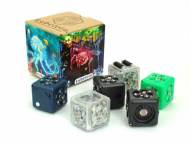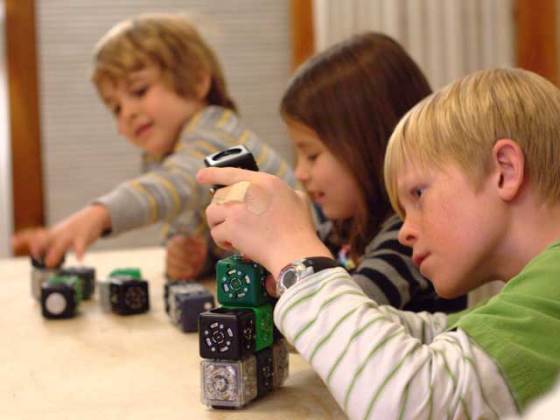Cubelets – robotic building blocks
 Building blocks from our childhood and our imagination enabled us to create new worlds and explore different ways to use what we had at our disposal. A year ago, Modular Robotics came up with Cubelets – simple robotic cubes which serve as building blocks that behave differently depending on how you connect them, like a physical form of programming where you just snap functions together to get results.
Building blocks from our childhood and our imagination enabled us to create new worlds and explore different ways to use what we had at our disposal. A year ago, Modular Robotics came up with Cubelets – simple robotic cubes which serve as building blocks that behave differently depending on how you connect them, like a physical form of programming where you just snap functions together to get results.
Developed by Eric Schweikardt and his team at Modular Robotics, a 2012 start-up that was spun off from Carnegie Mellon University with initial funding from private endowments and the National Science Foundation, Cubelets come in three categories: sense, think and act. Cubelets remind of Festo Molecubes we described in 2009, and they offer components of a standard robot — sensors, controllers and actuators.
“Cubelets are an example of a complex system. They’re made of lots of little cubes – each with a different capability, such as a distance sensor cube, a drive motor cube with wheels and a battery cube. And, when you put them together, they do something greater, such as drive when they detect an object”, said Schweikardt. “They’re inspired by natural systems of individuals that join forces and work together, such as insect swarms or birds flying in a ‘V’ formation.”
Cubelets are magnetic, electronic building blocks, each with a small computer inside, that can be connected in many different ways to move around a table, follow a hand signal, turn on a light, play sounds, or do many other creative tasks. The order of connections does matter, and you need at least three Cubelets to create an operating robot.
For example, you can connect four Cubelets: Brightness Sense block which responds to light, Flashlight Action block which glows, Inverse Think block which inverts the information among blocks it connects, and Battery block which serves as a battery. When you shine a bright light at your creation, it dims its light. When you switch off the lights, the brightness detection cube sends information to the Inverse Think block which inverts the amount of detected brightness into information how bright the Flashlight Action block should shine. That’s how easy you can create a night-lamp robot.
Introduction of Bluetooth Cubelet in early 2012 enables older kids and advanced users to connect to a Cubelets robot from a PC or phone. The connection allows you to see the code that each Cubelet is running, modify and wirelessly reprogram each Cubelet, right from an online IDE in a browser window. Unfortunately for fans of Apple products, the Bluetooth Cubelet isn’t compatible with Macs or iOS devices.
With Cubelets Control running on your Android device, you can override Action Cubelets and remote control your robot. You can drive them around like an RC toy car or control the Flashlight and Speaker Cubelets on from the next room. Communication works the other way too: you can read data from Sense Cubelets remotely.
With Cubelets Code running in a browser on your laptop or PC, you can connect to a robot, see which Cubelets are connected, see the program that they’re running, and wirelessly reprogram any or all of your Cubelets through C or a simple API to access basic behaviors.
Back when they were first presented, I didn’t write about Cubelets due to their price since I tried to focus on more affordable gadgets and toys. Current price of a single Cubelet ranges from $25 to nearly $50, while a set of six Cubelets costs $160. For a full list of Cubelets and their prices at the moment of reading, make sure to check the following page.
By changing the order and connections of Cubelets, the number of creations is practically limitless. While not being ideal for everyone due to their price, Cubelets are a great way to teach kids about how robots work without actually having to solder or know anything about programming – making them ideal for groups of elementary school students.










Leave your response!